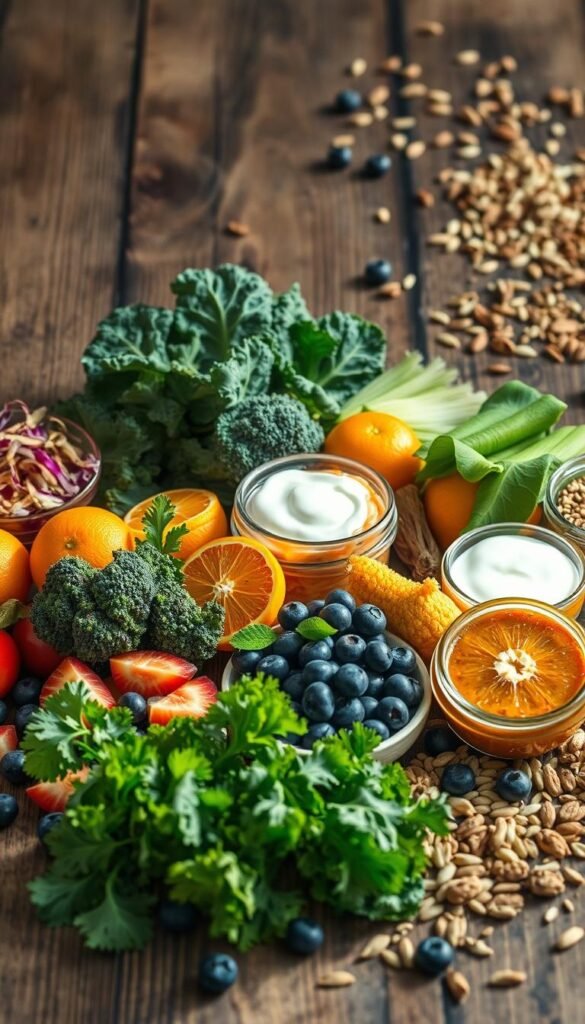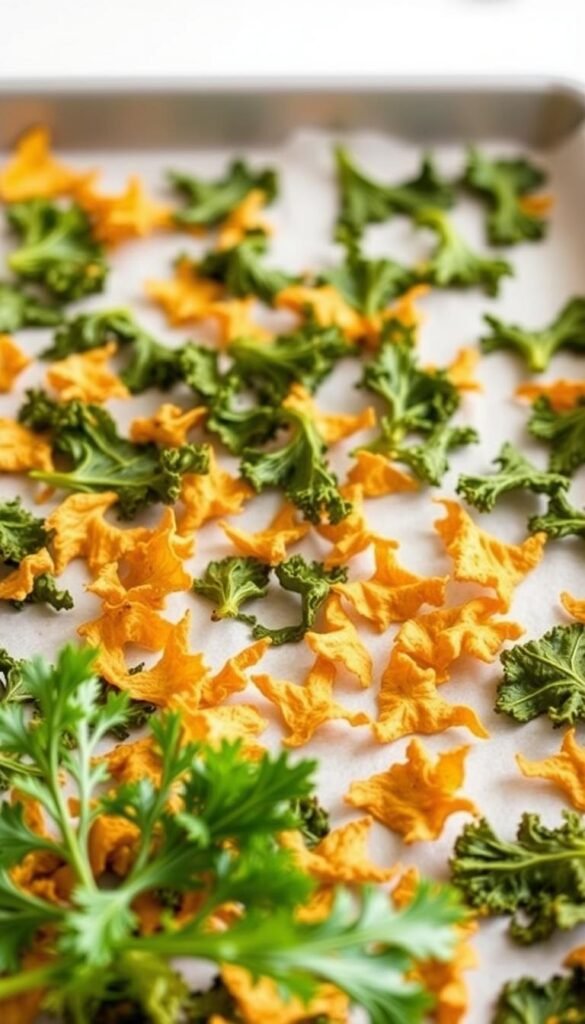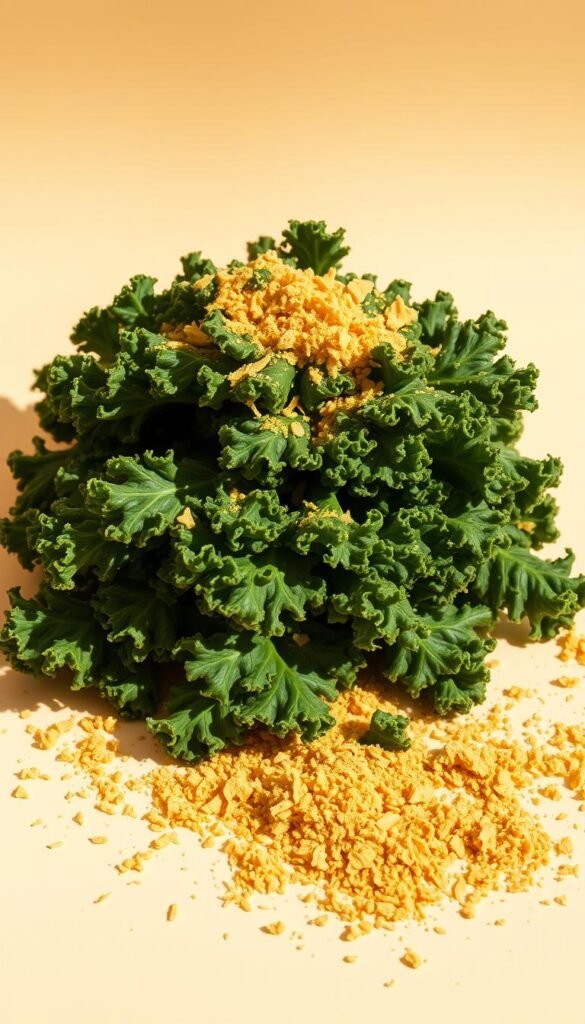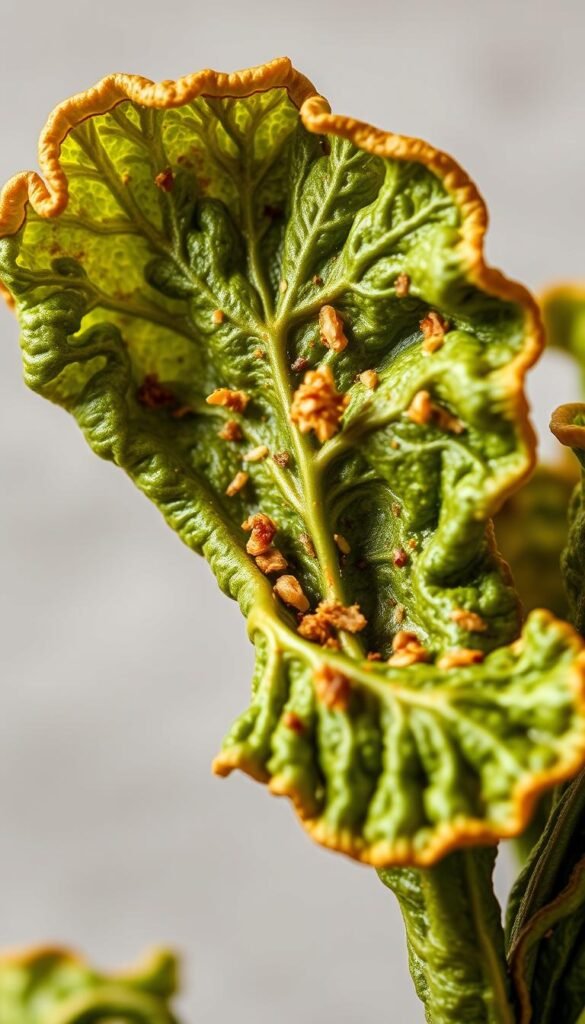Quite Cheezy Kale Krunch A healthy gut is the foundation of overall wellness. When your digestion thrives, your energy, immunity, and mood improve. One tasty way to support gut health? Nutrient-packed snacks like crispy kale chips.
I discovered the magic of kale chips during a trip to Whole Foods. The crunchy texture and savory flavor made it hard to stop at just one handful. Store-bought versions are convenient, but making them at home ensures freshness and lets you control the ingredients.
Beyond kale, there are 8 other powerhouse foods that enhance digestion and reduce inflammation. These options are easy to incorporate into meals and snacks. Best of all, they satisfy cravings while nourishing your body.
Key Takeaways
- Gut health impacts overall wellness, energy, and immunity
- Kale chips offer a crunchy, nutritious snack option
- Homemade versions beat store-bought for freshness and ingredients
- 9 specific foods support digestion and reduce inflammation
- These foods satisfy cravings while providing health benefits
9 Powerful Foods to Naturally Enhance Gut Health

Your digestive system thrives when fueled with the right foods. These nine options pack a punch for gut health, reducing inflammation and boosting digestion. Best of all, they’re easy to add to your meals.
1. Fermented Foods (e.g., Kimchi, Sauerkraut)
Naturally fermented foods are rich in probiotics. These live bacteria balance your gut microbiome. Kimchi and sauerkraut also contain fiber to feed good bacteria.
2. Yogurt with Live Probiotics
Look for labels mentioning “live cultures.” Yogurt’s probiotics aid digestion and strengthen immunity. Opt for plain varieties to avoid added sugars.
3. Ginger
Ginger’s anti-inflammatory properties soothe stomach discomfort. It also speeds up digestion, reducing bloating. Try fresh ginger in tea or grated over meals.
4. Bone Broth
Simmered bones release collagen, which repairs the intestinal lining. Bone broth is also rich in protein and amino acids. Sip it warm for maximum benefits.
5. Almonds
These nuts are prebiotic powerhouses. Their fiber feeds beneficial gut bacteria. A handful daily supports regularity and reduces inflammation.
6. Olive Oil
Polyphenols in olive oil fight inflammation. It also helps absorb fat-soluble vitamins. Drizzle it over salads or roasted veggies.
7. Bananas
Ripe bananas restore electrolytes and promote digestion. Their soluble fiber adds bulk to stools. They’re a perfect on-the-go snack.
8. Garlic
Garlic acts as a natural antimicrobial, targeting harmful gut bacteria. It also boosts immunity. Use it raw or lightly cooked for full effects.
9. Leafy Greens (Like Kale!)
Kale is loaded with fiber, vitamins A, C, and K, and enzymes that aid digestion. Eating it raw preserves nutrients. Pair it with lemon for better iron absorption.
“Fermented foods and leafy greens are cornerstones of a gut-friendly diet.”
For extra flavor and nutrients, sprinkle dishes with nutritional yeast. It adds a cheesy taste and B-vitamins. Combine these foods for a gut-healthy plate.
How to Make Quite Cheezy Kale Krunch at Home

Skip store-bought versions—homemade kale chips offer fresher flavor and better nutrition. Inspired by brands like Alive & Radiant Foods, this recipe balances crispiness with gut-friendly ingredients. Whether you use a dehydrator or oven, the result is a snack that’s as tasty as it is nourishing.
Healthy Ground Chicken Recipes for Easy Meals
Ingredients You’ll Need
Gather these simple ingredients for maximum flavor and texture:
- 1 bunch curly kale (stems removed, torn into chip-sized pieces)
- 1 cup raw cashews (soaked overnight for creaminess)
- 1/3 cup roasted red bell pepper (or raw for milder taste)
- 2 tbsp lemon juice (freshly squeezed)
- 2 tbsp nutritional yeast (for cheesy flavor)
- 1 tsp sea salt (adjust to taste)
Step-by-Step Instructions
- Blend the sauce: Drain soaked cashews, then blend with red bell pepper, lemon juice, and nutritional yeast until smooth.
- Massage the kale: In a large bag or bowl, coat each kale piece with sauce. “Cover like you’re seasoning popcorn,” ensuring even coverage.
- Choose your method:
- Dehydrator: 125°F for 8–10 hours until crisp.
- Oven: 220°F for 30 minutes, checking every 10 minutes to avoid burning.
Tips for Perfect Crispiness
Storage: Keep chips in a glass container—they stay crisp longer than in plastic. Avoid overcrowding trays; leaves need space to dry evenly.
Flavor twists: Add cayenne for heat or smoked paprika for depth. For kids, mix with popcorn to “sneak greens into snack time.”
Timing: Oven batches work faster but require closer monitoring. Dehydrators yield chewier textures if you prefer a bit of bend.
Why This Recipe Supports Digestion and Reduces Inflammation

The right ingredients can transform a simple snack into a digestion-boosting powerhouse. This recipe combines gut-friendly superstars—kale and nutritional yeast—with smart prep methods to maximize benefits.
Nutritional Yeast: A Gut-Friendly Powerhouse
Don’t let the cheesy flavor fool you. Nutritional yeast packs 3g protein per tablespoon and a full spectrum of B-vitamins. These nutrients fuel energy metabolism and support a balanced microbiome.
It’s also a rare plant-based source of B12, crucial for nerve function and red blood cell production. Sprinkle it on meals to boost immunity and digestion.
“Nutritional yeast is the unsung hero of gut health—delicious, versatile, and packed with nutrients.”
Kale’s Role in Gut Health
Kale’s insoluble fiber acts like “nature’s scrub brush” for your intestines. It sweeps waste through your digestive tract, preventing bloating. Raw prep preserves 40% more enzymes than baking, aiding nutrient absorption.
Dehydrating at low temps (under 115°F) keeps vitamins A, C, and K intact. Store-bought versions often lose these to high-heat processing.
- Cost control: Homemade lets you choose organic kale and limit sea salt.
- Probiotic boost: Pair with fermented foods like kimchi for extra GanedenBC30 benefits.
- Anti-inflammatory perks: Add turmeric to mimic store-bought flavors with less sodium.
Conclusion
Upgrading your snack game supports digestion and energy levels. The nine superfoods we covered—like fermented foods and leafy greens—work together to reduce inflammation and keep your gut balanced.
Homemade kale chips outshine store-bought products. They’re fresher, packed with nutrients, and free from additives. Try adding miso paste to the recipe for umami depth. Store them in an airtight bag—they stay crisp for up to three days.
Share your creations with us! Tag @YourBrand when you make a batch. Every crunch is a step toward better health. Your gut will thank you.

